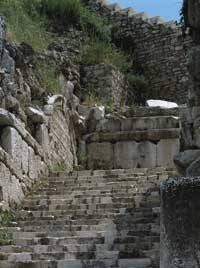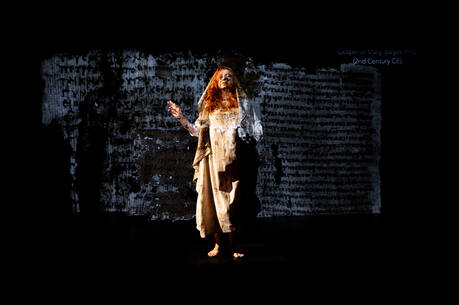Last spring Pope Benedict XVI dedicated a special jubilee year to the Apostle Paul, from June 28, 2008, to June 29, 2009, to mark the second millennium of his birth. Ecumenical Patriarch Bartholomew of Constantinople joined the pope in Rome for the opening liturgies, and both of them invited Christians to celebrate this jubilee, which includes the making of pilgrimages. Having made Pauline pilgrimages in Turkey on a number of occasions, I will describe some destinations that fall a bit off the popular tourist routes but provide ample opportunity for learning and spiritual experience.
Anatolia, Cappadocia, Tarsus…
Let us begin in southeastern Anatolia. If your group flies into Ankara (Ancyra), you will want to visit the Temple of Augustus and of Rome and the Museum of Anatolian Civilizations, with the world’s best display of Hittite materials. Most tourists also visit the Mausoleum of Ataturk, founder of modern Turkey. An international team of Jesuit priests staffs a small Catholic community with Masses in English at the Meryem Ana Church on the ground of the Apostolic Nunciature (Vatikan Büyük Elçiligi) in çankaya.
After a few hours on a bus you arrive in Cappadocia, which is a World Heritage site and has in recent years become a major tourist destination in Turkey. (Alternately, your air carrier may take you directly to Cappadocia or to Adana.) Some of the most surreal and amazing landscapes in all of Asia Minor await the visitor here. You may visit remains of ancient cities, vineyards and wineries, and stunning rock-cut churches from the sixth through the 11th centuries. These small chapels, carved in tufa rock, contain original iconic representations of biblical scenes and saints of the Eastern Church. Cappadocia provides a rich entree to the church life of the patristic era.
Traveling south you pass through the famous Cilician Gates in the Taurus Mountain range, and as you near the Mediterranean coast you arrive at Tarsus, birthplace of St. Paul. This town has grown recently because of tourism related to St. Paul and a population shift in Turkey from the country to cities. Dating back to Hellenistic times, Tarsus was an important site; in Roman times Cicero was governor there, and Antony and Cleopatra met there. Pilgrims can visit St. Paul’s Well and a Roman street section, recently excavated, that gives an excellent idea of a city scene in the time of St. Paul. The church building has been tastefully renovated and now operates as a museum; pilgrim groups may receive permission to worship there. Two sisters, members of an Italian congregation, live next door and staff a center; they offer kind hospitality to pilgrims and people of the town.
Visitors to this part of Turkey generally stay in the provincial capital, Adana, a bustling city with a growing population and one of the largest new mosques in Turkey. The Catholic parish here is served from the diocesan headquarters in Iskenderun.
A 100-mile journey south leads to Antakya (Antioch on the Orontes), “where the disciples were first called Christians.” Because of its remote location, this city receives fewer visitors than most other cities in western Asia Minor. Originally built as a Hellenistic city after the death of Alexander the Great, it was the seat of the Antiochus Epiphanes IV, archenemy of the Jews in the Maccabean era. In Paul’s day it was the third largest city in the Roman Empire. Later, Antioch was home to St. Ignatius of Antioch and St. John Chrysostom.
The ancient city is situated between the Orontes River on the west and Mount Stauris. On its western slope one finds St. Peter’s Grotto, originally a cave possibly used as a meeting place by the early Christian community that included Barnabas, Paul and Peter. Capuchin Franciscans administer this sanctuary and celebrate Mass occasionally, especially for pilgrims.
Visitors to the area today should not miss the Hatay Museum in the city center; it contains one of the world’s largest collections of Roman mosaics (from the second to the sixth centuries A.D.) from Antioch, Daphne and nearby Seleucia, the port from which Paul and Barnabas embarked. Pilgrims will want to visit the historical center in the Jewish quarter, where a Jewish synagogue, an Orthodox church and a Catholic church are found today. A Capuchin priest, Domenico Bertogli, and his parishioners welcome pilgrims; and he happily describes the warm relations between Catholics and Orthodox in this city, built on mutual respect and the ability of Catholics there to follow the Orthodox Church calendar. Located in a cluster of houses and a courtyard, this church offers a unique model of an early Christian “house church.”
Theaters, Museums, Shrines
Several other areas on the Mediterranean coast of Turkey beckon Pauline pilgrims. Antalya (Attalia) offers a pleasant site for visiting, with a lovely harbor, some remains of first-century Roman walls and Hadrian’s gate (second century). Nearby you find the impressive remains of Perge (Perga), a typical Hellenistic city, through which Paul passed when traveling to Pamphylia from Cyprus; he also visited at the end of this journey before sailing back to Antioch. One can imagine Paul walking through the imposing Hellenistic city gate that one sees today, as he and Barnabas headed north to Antioch in Pisidia. Visitors should take a short trip east to Aspendos (and also to Side) to see impressive Roman theaters; the theater in Aspendos still hosts a summer opera season. The Antalya Museum contains a rich collection of Hellenistic and Roman sculpture and art, as well as a small collection of early Christian remains and some relics of St. Nicholas, who lived in the nearby region of Lycia.
On the southern shore I recommend a particularly scenic drive east into Lycia to visit Demre (ancient Myra, where Nicholas was bishop) and Kalkan (for the archeological park of ancient Patara, birthplace of Nicholas). You could be the only visitors at Patara, located near a popular Mediterranean beach park, but here you can breathe in the feel of an ancient city as you sit in its amphitheater, which provides an excellent place for group prayer. Further east in Demre you will find large groups of pilgrims from Russia and Ukraine coming to visit the church of St. Nicholas; he was buried here before Italian merchants took his remains to Bari. You can find shops and cafes named after Santa Claus (Baba Noel in Turkish), as well as Orthodox icons and texts in Cyrillic characters. Midway between Patara and Demre lies the beautiful Turkish coastal town of Kas, a good place for an overnight stay.
Traveling north from Antalya past Lake Egirdir, set amid mountains, you come to a cluster of cities visited by Paul and Barnabas on their first missionary journey (Acts 13-14). First is the Anatolian highland town of Yalvac (Antioch in Pisidia), where one can visit spectacular excavations of the Roman colonial town, with remains of a Byzantine-era Basilica of St. Paul. You can view a Roman aqueduct in the distance nestled at the foot of snow-capped mountains. Next on the route comes Konya (Iconium), where little of the former Roman city remains visible; but one should visit the mausoleum shrine of the Sufi Mevlâna Jalâluddîn Rumi, “founder” of the Whirling Dervishes. In Konya seek out the Catholic Chapel of Sts. Paul and Thecla, administered by two sisters from Italy; there again expect great hospitality. Catholic priests visit Konya only four or five times a year, so these sisters welcome visiting pilgrim groups, especially for prayer or Mass. From Konya some travelers go southeast to Hatunsaray (Lystra) or to Kirbasan (the mound of ancient Derbe), identified but not yet excavated. You would need to ask directions to find these sites.
Farther north, I recommend a visit to the Lycus Valley; the regional center is Denizli. Here all tours go to the charming site of Pammukale (ancient Hierapolis), with its chalklike cliffs and warm mineral springs. Behind the site lies a Roman city and an extensive cemetery; a martyrion of St. Philip the deacon greets those enthusiastic enough to trek up the mountainside. From this site you can look west across the valley at the remains of ancient Laodicea, one of the seven cities of the Book of Revelation (“neither hot nor cold”); just recently archaeologists have begun to work there. Looking southwest one can almost see the site of Colossae, which has not been extensively excavated and is not easy to reach. Yet one may imagine the people whom Paul addressed in his Letter to the Colossians and in his Letter to Philemon, who lived in Colossae.
All tours and pilgrimages will move west to Selcuk (ancient Ephesus) and its wonders: a beautifully excavated site of streets and temples, the library of Celsus, an ancient theater and a Christian basilica that may have been the site of the Council of Ephesus (431), which named Mary “Mother of God” (Theotokos). Nearby you can visit the famed Temple of Diana (Artemis) and the Basilica of St. John the Evangelist. Pilgrims should conclude this visit with a drive up to the House of the Virgin Mary, considered by some to be her home and the place where she died. A serene, beautiful site for a stop, for prayer or for celebration of Mass, it also offers a lovely surprise: both Christians and Muslims venerate this site as a holy place, affording a unique interreligious experience. Here again one finds Franciscan friars and sisters welcoming pilgrims.
A final stop should take you to Miletus, about an hour south of Ephesus. Here St. Paul stopped on his final journey to Jerusalem and invited all the elders and leaders of the church in Ephesus to come for his touching farewell to them. Since it is situated in a very rural area, you might experience some quiet here as you walk around extensive ruins and another beautifully preserved Roman theater. A group might find the theater a good setting for prayer, recalling the mutual affection of Paul and his friends from Ephesus now memorialized in this place.
Choosing a Tour
St. Paul’s journeys were many and the distances covered vast. A complete itinerary would require travel to Israel (Jerusalem), Syria (Damascus), Cyprus, Rhodes, Turkey (Asia Minor), Greece, Malta and Italy (especially Rome). Most of these destinations appeal to tourists, but a comprehensive itinerary lies beyond the reach of most pilgrims.
You will need to consider the differences between pilgrimage, study tour and sightseeing tours. Many tours focused on sightseeing visit some sites associated with St. Paul (e.g. Ephesus, some Greek Islands, Athens and Corinth, Delphi) but do not treat them as religious sites. Study tours include in-formed talks on the life and mission of St. Paul and the spread of the early church. They usually add the seven churches of the Book of Revelation to places already mentioned, and give a good sense of religious history as well as cultural and historical introductions.
Pilgrims may follow a similar itinerary but devote more attention to daily prayer and worship, and to some encounters with contemporary church people who live in these sites. Often these visits provide longer-lasting memories than any others and remind us what we share with those Christians who still live in these areas. Views, vistas and visits will leave a lasting impression of the world of Paul and the early church; afterward you will never hear or read the Acts of the Apostles or the Pauline Epistles the same way again.
View a slideshow of Pauline pilgrimage sites.








